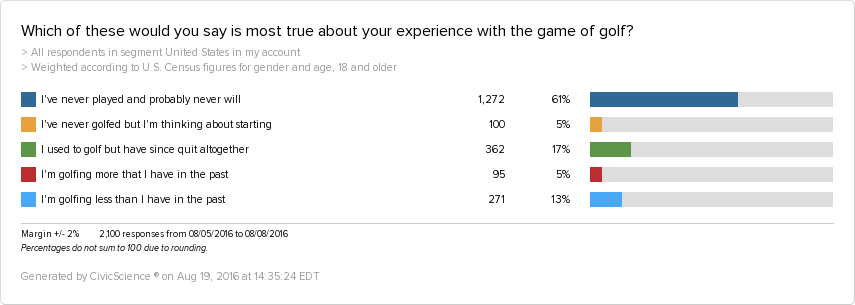I’m an avid golfer, to say the least. I’ve played since I was a kid, captained my high school team, and still maintain a respectable handicap. I spend more time and money on golf than on any other recreational interest I have.
But I’m also the first one to acknowledge that the sport is in trouble. The decline in recreational play and the closure of numerous golf courses in the U.S. over the past 20 years is well-documented. Nike’s recent announcement that they’re divesting their golf equipment business is more than just a canary in the coal mine. When one of the smartest consumer brands in the world sees a bleak future for golf, it can’t bode well for the course owners, country clubs, resorts, and every other business tied to the game. In other words, the Donald Trumps of the world, with millions and even billions wrapped up in the sport, can’t like what they see.
Golf isn’t struggling because of the macro-economy, as some people might think. Yes, the game is expensive to play, but money isn’t the direct driving force. The data seem to suggest something else. There are cultural and societal sea changes underway that show very few signs of reversing.
At CivicScience, we have studied and written extensively about the economic impact of U.S. households with two working professional parents, where an increasing level of work and financial load is falling on women’s shoulders. As men are being asked (or choose) to take on more responsibility at home and with their children, the amount of time and bandwidth left over for lengthy, non-family-oriented recreational activities like golf is disappearing.
Think about it. There was a time when men would work all week, spend 4-6 hours on Saturday (and sometimes also Sunday) playing golf with the boys; followed by cigars and scotch in the clubhouse; then show up at home half-loaded until they passed out on the couch (watching golf); all while spending a non-trivial amount of the family budget at a club where their wives were treated like second-class citizens. Yeah, those days are fleeting.
Don’t believe me? Take a look at this:

Over their lifetime, 40% of U.S. adults (55% of men and 25% of women) have tried golf or intend to. The bad news? The number of people who used to golf but have since quit is more than three times larger than the group of potential new players. Among men only, the rate is more than 5 to 1. Making things worse, active golfers are reporting a decrease in play at a rate more than 2.5X greater than those who are playing more. I, for one, played half as many rounds of golf in 2016 as I did last year – for all of the reasons I mentioned above.
The demographics are troubling as well. As expected, the overwhelming percentage of lapsed and decreased-play golfers are men. People who claim they are thinking about taking up the sport are, believe it or not, slightly more likely to be women. Where the game is seeing decreased play is largely among people aged 35-54, the college-educated, and those with a household income in the $75K-$125K range. Only 6% of Millennials say that they are planning to take up the game in the future.
Reinforcing my point, married men are half as likely as non-married men to say they are considering taking up the game and 22% more likely to say their rate of play is decreasing.
Recreational golf, country clubs, and guys-only golf trips may have said farewell to their Golden Age. And, given the acceleration of two-member working households, equitable parenting arrangements, and the overall busyness of today’s consumer, there is little evidence that we will see a resurgence anytime soon. No matter how many new resorts he opens, Donald Trump is not going to make golf great again.








